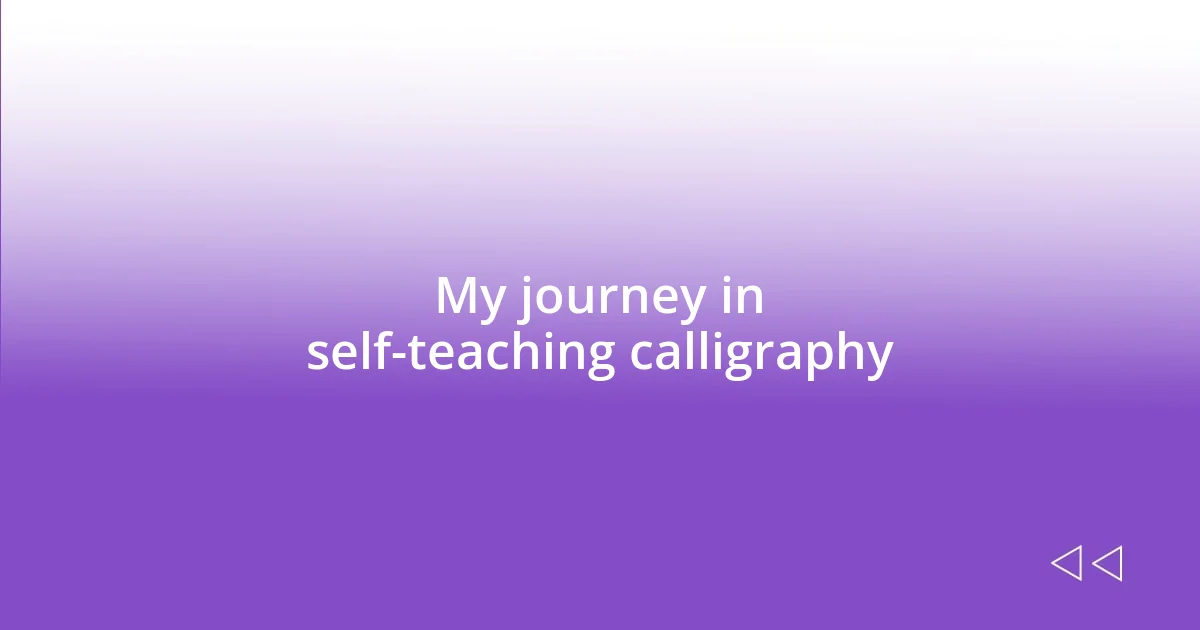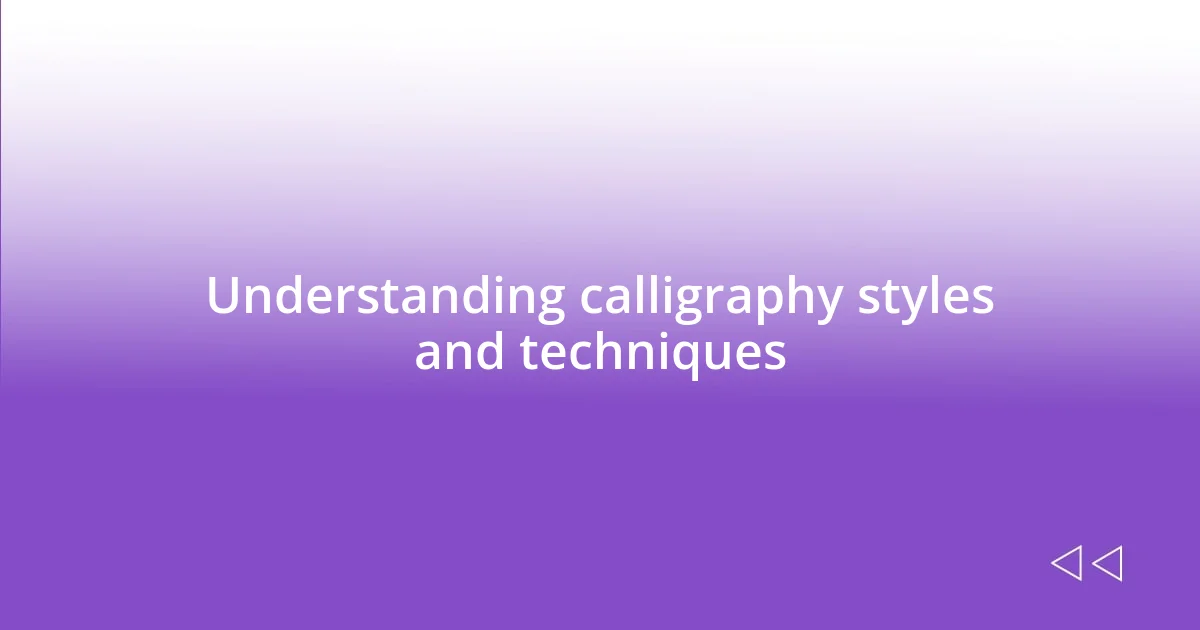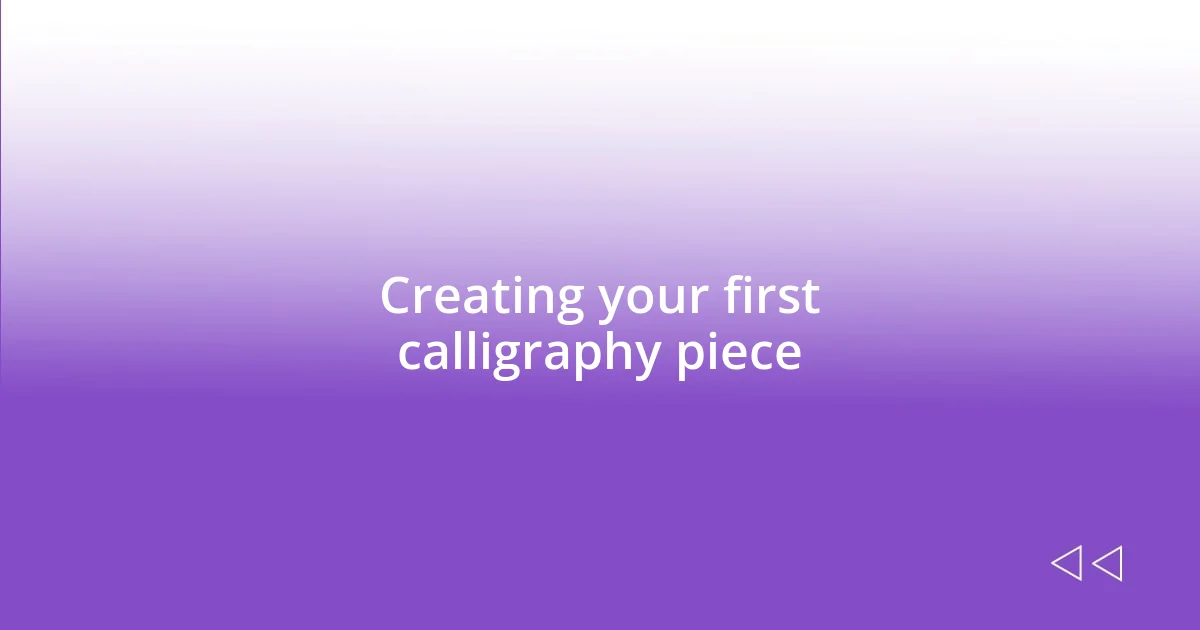Key takeaways:
- Initial excitement and fear of calligraphy led to a discovery of patience, persistence, and emotional expression through each stroke.
- Selecting quality calligraphy tools, like nibs and paper, greatly impacts the writing experience and allows for personal creativity.
- Breaking down practice into smaller parts, using the right tools, and maintaining consistency are essential for improvement in calligraphy skills.

My journey in self-teaching calligraphy
Embarking on my journey to self-teach calligraphy felt like opening a treasure chest of creativity. I remember the first time I dipped my nib into ink; the excitement was palpable, but so was the fear. Would I make a beautiful letter or a mess? That hesitation lingered until I saw the satisfying flow of ink creating my first capital “A.”
As I delved deeper, I found that every stroke told a story, every loop and line reflecting not just my learning, but my emotions. There were days of frustration when my pen wouldn’t glide smoothly, and I felt like giving up. But in those moments of struggle, I learned the value of patience and persistence. How could I rest when each imperfect letter was a step towards my own unique style?
I also discovered the joy of finding my rhythm. Late nights spent practicing in my cozy nook, surrounded by flickering candlelight and a gentle playlist, transformed tedious drills into a meditative ritual. It made me wonder—what if I had never picked up that pen? My life would lack the creative outlet that’s now become such an integral part of who I am. Each session became a little celebration of progress, and I began to cherish those moments just as much as the finished pieces.

Choosing the right calligraphy tools
Choosing the right calligraphy tools can transform your experience from daunting to delightful. I still remember my first trip to the art supply store, where I felt overwhelmed by the choices. It’s tempting to go with whatever looks fancy, but I found that quality matters more than aesthetics. A good nib can make all the difference in how smoothly your ink flows and how sharp your letters appear.
To help you make the best selection for your own journey, here’s a list of essential tools to consider:
- Nibs: Start with a couple of different styles, like pointed and broad-tipped, to explore various lettering styles.
- Inks: Experiment with both liquid and gel inks. I discovered that color often influenced my mood while practicing.
- Paper: Choose smooth paper to allow your nib to glide effortlessly. I found certain papers absorbed ink differently, which affected the final look.
- Pen Holder: Invest in a comfortable pen holder that fits well in your hand. I learned the hard way that the right grip can prevent fatigue during longer sessions.
- Ruler and Pencil: A good ruler and pencil are key for creating guidelines. I used them religiously in my early days, which helped maintain consistency and alignment.
As I navigated the world of calligraphy, I felt a sense of joy in selecting each tool. It was like building my own little arsenal for creativity, one that I grew to love and could rely on during practice sessions.

Understanding calligraphy styles and techniques
Understanding the various styles and techniques in calligraphy has been an enlightening journey for me. Initially, I was captivated by the elegance of Copperplate and the bold strokes of Gothic. Each style opened up different emotional channels for me as I practiced. With Copperplate, there was a certain grace in executing the curves, almost like dancing with the pen. In contrast, the Gothic style had a more powerful and structured feel, making each letter feel like a bold statement. I often found myself switching between styles depending on my mood. Isn’t it fascinating how our emotions can shape the art we create?
As I explored different techniques, I learned that mastering the basic strokes was crucial. I spent hours practicing the foundational elements like loops, downstrokes, and upstrokes. These foundations allowed me to delve deeper into the complexity of each style, helping me build confidence with more intricate letters. I remember feeling a rush of excitement when I first achieved a perfect flourish; it was as if I had unlocked a new level of skill. This realization made me appreciate the patience needed in this art form. How often do we rush through learning? I certainly did, but I learned to embrace the process rather than just focus on the outcome.
Moreover, I discovered that blending styles could lead to captivating results. I began experimenting by combining elements from different scripts, creating a unique fusion that felt true to my personality. It was like mixing colors on a palette—each brushstroke adding character and depth. This personalization not only made my work stand out but also gave me a sense of ownership over my creations. Have you ever tried merging techniques in your own creative endeavors? The beauty of calligraphy lies in those individual choices that reflect who we are.
| Calligraphy Style | Description |
|---|---|
| Copperplate | Elegant script characterized by its flowing curves and fine details. |
| Gothic | Bold and angular letters that convey strength and structure. |
| Modern Calligraphy | A contemporary style that focuses on individual expression and creativity. |
| Brush Calligraphy | Uses brushes to create sweeping, expressive strokes that mimic painting. |

Practicing with basic strokes
Practicing basic strokes is where the foundation of calligraphy truly begins, and I can’t stress enough how pivotal this phase was for me. I remember spending countless evenings just repeating simple motions like downstrokes and upstrokes. At first, they felt mundane, almost tedious. But with each stroke, I began to feel the nib transform into an extension of my hand, creating a connection that made the repetitive practice worthwhile. Have you ever found beauty in the simplest tasks? For me, those basic shapes became a calming ritual.
As I moved deeper into practicing basic strokes, I realized that my posture and grip made a significant difference. I experimented with different angles, discovering that a slight tilt could produce varied thicknesses in my letters. I often found myself leaning over the paper, completely lost in the moment. It’s fascinating how making a small adjustment can yield such striking results. I often chuckled at my initial struggles—who would’ve thought that something as simple as holding a pen could take so much thought?
Repetition was both my best friend and my toughest critic during this stage. I noticed that the more I practiced, the more my confidence grew. Early on, I had a breakthrough while drawing a perfect loop; it felt like a tiny victory, one that kept me motivated to keep going. Sometimes I’d marvel at how something so straightforward could actually foster such creativity. I remember asking myself, “How can these simple strokes evolve into beautiful words?” The answer became clear: it’s in the practice, the persistence, and the joy of watching your skill evolve with each stroke.

Creating your first calligraphy piece
Creating your first calligraphy piece can be both exhilarating and intimidating. I remember when I finally decided to put my training to the test. I chose a simple quote that resonated with me and, with a deep breath, I set my pen to paper. That moment was filled with anticipation and nervous energy; it felt like I was about to take my first steps into a wide-open world of creativity. Have you ever felt that rush when trying something new?
As I began to write, my heart raced with each stroke. I would halt mid-creation, sometimes doubting if my letters would truly capture the essence of the quote. It’s interesting how self-doubt can creep in during such a personal endeavor, isn’t it? I found myself embracing the imperfections, realizing that they added character to my first piece. Every wobble in a letter felt like a testament to my journey, a sign of the effort and time invested. In that moment, I discovered that the process of creating was just as important as the final product.
After countless trials and errors, I finally completed my piece. The sense of pride I felt was overwhelming. It wasn’t just about the beautiful letters that adorned the page; it was about the hours of practice that led me there. I remember glancing at that piece, a mix of wonder and joy flooding through me. What I learned is that your first creation isn’t merely a display of skill but a celebration of where you started, a stepping stone to all the art yet to come. Have you taken that leap yet? If you haven’t, I encourage you to dive in—you might just surprise yourself!

Tips for improving your calligraphy
To truly elevate your calligraphy, I found that breaking down your strokes into smaller, manageable parts can make a world of difference. It might sound elementary, but focusing on just one letter at a time helped me nail the nuances of each curve and line. Have you ever memorized a song by practicing just a few bars? It’s that same principle—master the small pieces, and soon they all come together beautifully.
Another tip that I learned through trial and error is the importance of choosing the right tools. I remember being frustrated with my first pen, which felt scratchy on the paper. After switching to a smoother nib and experimenting with different types of ink, my letters began to flow effortlessly. It’s amazing how the right tool can transform your experience. So, consider this: Do you have the best tools at your disposal? If not, taking the time to explore can yield surprising results.
Lastly, I discovered that setting aside dedicated practice time was crucial. Life often gets busy, but I found that consistency was the key to improvement. I started treating my calligraphy practice like an appointment I couldn’t miss. Believe me, those daily sessions, no matter how short, built momentum. It’s like watering a plant; even a little bit goes a long way. When was the last time you prioritized your passions? Making space for what brings you joy can significantly enrich your creative journey.














